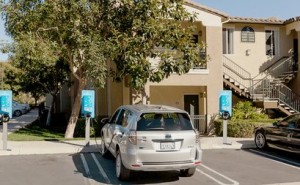Editor’s Note: With plug-in electric vehicle (PEV) charging station operator ChargePoint announcing its multi-unit dwelling charger for apartments and condominiums, I contacted an industry expert on this topic. Joel Pointon, former PEV Program Manager at San Diego Gas & Electric (SDG&E) and Principal at JRPCharge Consulting, serves as co-chair of the California Plug-in Electric Vehicle Working Group for Multi-unit and Workplace Vehicle Charging. Pointon and colleagues see the vast opportunity of bringing more multi-unit chargers to PEV owners – along with several challenges that must be addressed.
Since the introduction of truly commercial plug-in electric vehicles (PEVs) in late 2010, we have firmly established that drivers do more than 80% of their charging at home. It makes perfect sense…… if you live in a single family home and control your parking area. But in reality a significant portion of our population lives in multi-unit dwelling communities (owners and renters) and do not have control over their parking their vehicles – sometimes without any assigned parking. Over 50% of San Diego and 66% of San Francisco residents live in these communities, and future land use planning only points to increasing numbers for both urban and near urban neighborhoods. Although electric-powered vehicles are often a perfect fit for this population, most give up considering it because of the challenges of getting the cooperation of property management and other residents. There’s also the challenge of addressing infrastructure limitations that never considered supplying electricity to parking areas.
After working with the stakeholders in these communities for over five years via workshops and lectures, it has become obvious that there is a real need for education and outreach. The challenge is reaching municipalities, utilities, property management companies, and residents for creating the awareness base – and for better understanding the confusing spectrum of options available to meet this presently unmet need.
Legislative solutions, while well intentioned, have not advanced the cause as of yet. Presently in California, SB 880 and AB 2565 for HOA and rental properties respectively, have attempted to assist individuals that wanted to go it alone and try to install their own charging units in these communities. Unfortunately, both cite a liability insurance provision of $1 million dollars naming the community; that is something the insurance industry has largely not been willing to offer to their customers in these communities. In the past year, the slow pace of progress has prompted all three of the California investor-owned utilities to offer rate-based pilot projects to the California Public Utilities
Commission (CPUC) to consider for multi-unit (and workplace) charging. These range in scope from “make ready” wiring to basically turnkey offerings for charging in these residential environments (applications are available at the CPUC website).
Private offerings have included the NRG eVgo – CPUC settlement offering of “free installation” for charging units where residents pay a monthly fee for access and power; and the recent ChargePoint press release announcing a “packaged” market focus for multi-units. The good news is that gradually the spectrum of charging offerings will continue to expand for this underserved market. Focus in the future will need to stress flexible, cost effective, and innovative approaches in order to become truly successful.
So where to start? What’s the vocabulary? What’s the technology spectrum? This may be a bit overwhelming for someone just approaching the topic. As co-chair of the California Plug-in Electric Vehicle Working Group for Multi-unit and Workplace Vehicle Charging, let me suggest the free downloadable guides available on their resources page as a primer (PEVCollaborative.org) ….and also the free survey available for property managers to “take the temperature” of electric drive appetite within their communities.
When will we know that we have reached the tipping point for making electric fuel an option in these communities? When we finally see PEV charging listed as a standard amenity to attract residents, just as they do a pool or clubhouse today. Until then, we have much work ahead of us.
Joel Pointon, former PEV Program Manager at SDG&E and Principal at JRPCharge Consulting, can be reached by email at JRPCharge@gmail.com.

